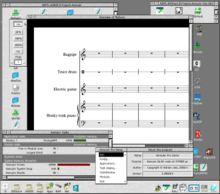Aemulor
 | |
| Original author(s) | Adrian Lees |
|---|---|
| Initial release | March 2003 |
| Stable release |
2.32[1]
|
| Operating system | RISC OS |
| Type | Emulator |
| License | Proprietary commercial software |
In computing, Aemulor is a emulator of the earlier 26-bit addressing-mode ARM microprocessors which runs on ARM processors under 32-bit addressing-mode versions of RISC OS. It was written by Adrian Lees and released in 2003. An enhanced version is available under the name Aemulor Pro.
The software allows Raspberry Pi,[2] Iyonix PC and A9home computers running RISC OS to make use of some software written for older hardware. As of 2012, compatibility with the BeagleBoard single-board computer was under development.
Development
The software's existence was first reported around the time of the announcement of the Iyonix in October 2002.[3][4] A demo version was released in February 2003,[5][6] with the commercial release in March of that year.[7][8][9]
Aemulor Pro was released in 2004. This added enhancements, including support for low colour modes, required by scorewriter Sibelius and many games.[10][11][12] A version for the A9home was released in 2005.[13] The software was exhibited at the 2006 Wakefield Show.[14]
In 2009, author Adrian Lees[15][16] posted on The Icon Bar, showing an early prototype of the software running on the BeagleBoard.[16][17] Progress on further compatibility for the Raspberry Pi single-board computer was announced by Lees on the RISC OS Open forum in 2012.[18] Developer R-Comp was reported in May 2012 to be hoping to make Aemulor available for its BeagleBoard-xM-based ARMini computer.[19]
Features

The software provides full 26-bit emulation[7] for applications written in C and ARM assembly language. It employs an XScale-optimised ARM code interpreter, supports SWI emulation from RISC OS 4 to 5, flag preservation and creation of dynamic areas in low memory.[20] Support for running A310Emu is included, allowing users to further emulate earlier versions of the OS, going back to Arthur.[21] As of 2003, due to the memory remapping employed, native 32-bit applications are restricted to a maximum size of 28Mb while Aemulor is running.[22]
The original release included an Easter egg, with a prize of an upgrade to the Pro version for the person who found it.[23][24]
Aemulor Pro adds support for low-bpp screen modes, sound, hardware emulation of VIDC/IOC, an altered memory map and 26-bit filing systems.[20] Some software, such as Sibelius, can be run both in the desktop and in full screen.[10]
Compatible software
| Title | Purpose | Vendor/publisher |
|---|---|---|
| ArtWorks[25] | vector graphics | MW Software |
| Impression[25] | desktop publishing | Computer Concepts |
| Sibelius[10] | scorewriter | Sibelius Software |
| Spheres of Chaos.[26] | video game | |
| StrongED[25] | text editor | |
| Zap[25] | text editor |
References
- ↑ "Aemulor Pro online manual". Spellings Computer Services. Archived from the original on 12 February 2007. Retrieved 29 June 2012.
- ↑ http://www.raspberrypi.org/phpBB3/viewtopic.php?f=55&t=31593
- ↑ Williams, Chris (20 October 2002). "Iyonix 26 bit emulator in development". Drobe. Retrieved 21 June 2012.
- ↑ "32-bit introduction". IYONIX pc. Castle Technology. Retrieved 29 June 2012.
- ↑ Williams, Chris (22 February 2003). "South West show news". Drobe. Retrieved 21 June 2012.
- ↑ Williams, Chris (9 March 2003). "South West show news". Drobe. Retrieved 21 June 2012.
- 1 2 Williams, Chris (25 March 2003). "Aemulor sees the light of day". Drobe. Retrieved 27 June 2012.
- ↑ Hoare, John (25 March 2003). "Aemulor Released". Acorn Arcade. Retrieved 29 June 2012.
- ↑ Peachey, John (June 2003). "Aemulor in Use". Archive. 16 (9). Retrieved 29 June 2012.
- 1 2 3 Williams, Chris (12 March 2004). "Aemulor Pro embraces Sibelius". Drobe. Retrieved 21 June 2012.
- ↑ Mellor, Phil (6 May 2004). "Aemulor Pro is out now". Acorn Arcade. Retrieved 29 June 2012.
- ↑ Lee, Jeffrey (22 April 2004). "Aemulor Pro-gress". Acorn Arcade. Retrieved 29 June 2012.
- ↑ Williams, Chris (5 November 2005). "Aemulor for the A9home released". Drobe. Retrieved 21 June 2012.
- ↑ "Wakefield 2006". RISC World. 6 (6). Retrieved 29 June 2012.
- ↑ Lees, Adrian. "The homepage of Adrian Lees". Adrian Lees. Retrieved 29 June 2012.
- 1 2 Naulls, Peter (20 December 2009). "Aemulor on BeagleBoard". riscos.info. Retrieved 29 June 2012.
- ↑ Lees, Adrian (20 December 2009). "Aemulor BeagleBoard". TIB forum. The Icon Bar. Retrieved 29 June 2012.
- ↑ Lees, Adrian (20 June 2012). "Aemulor on the Beagle/Panda boards". ROOL forum. RISC OS Open. Retrieved 29 June 2012.
- ↑ Proven, Liam (10 May 2012). "Best and the Rest: ARM Mini PCs". Reg Hardware. Retrieved 29 June 2012.
- 1 2 "Aemulor Professional". Spellings Computer Services. Retrieved 29 June 2012.
- ↑ Williams, Chris (19 April 2003). "Aemulor turns to RISC OS 2". Drobe. Retrieved 21 June 2012.
- ↑ "Inside Aemulor". Foundation RISC User. Retrieved 29 June 2012.
- ↑ Williams, Chris (5 August 2003). "Aemulor 2.2 upgrade online". Drobe. Retrieved 21 June 2012.
- ↑ Williams, Chris (19 December 2003). "Aemulor's brief Windows affair discovered". Drobe. Retrieved 21 June 2012.
- 1 2 3 4 Williams, Chris (19 November 2002). "Aemulor: Number of apps working on Iyonix 'growing daily'". Drobe. Retrieved 21 June 2012.
- ↑ Brett, Paul. "Games World". RISC World. Retrieved 29 June 2012.